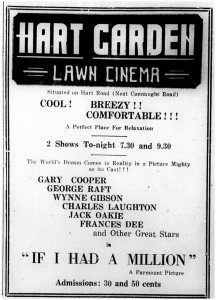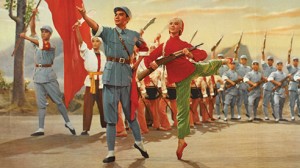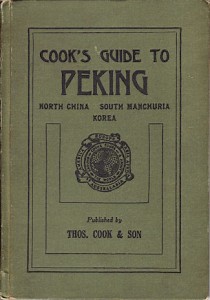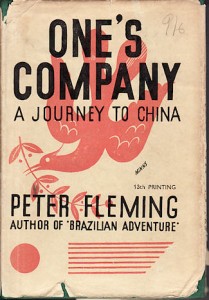Posted: June 2nd, 2013 | No Comments »
Outdoor cinema has made something of a comeback in many cities around the world in recent years, but not in China to my knowledge. However, back in the thirties outdoor cinema was popular. In Shanghai there were weekend screening in Hongkew Park (now Lu Xun Park) as well as at the Hart Garden Lawn Cinema up on Hart Road (now Changde Road) close to the junction with Connaught Road (now Kanding Road). In 1934 the Hart Garden was actually showing 1932’s If I had a Million with an all-star cast. It seems like a pretty cheap date – 50 cents for the best seats. Just hope the rain stayed away….

Posted: June 2nd, 2013 | No Comments »
To my surprise the story of the magician Chung Ling Soo popped up on The One Show on BBC1, of all places. I’ve blogged about Chung Ling Soo, actually William Ellsworth Robinson, an American magician who worked mostly in Britain before the First World War impersonating a Chinese magician in full mandarin regalia. Most of the audience never had any idea that he wasn’t Chinese. There is little film of him – except this short clip of him welcoming back soldiers from the front to London (which I’ve blogged previously here). Famously Chung Ling Soo/Robinson died when his version of the bullet catching trick (set against a backdrop of the Boxer Rebellion!) went wrong at the Wood Green Empire music hall. By the way, there’s a great biography of Robinson called The Glorious Deception.
Anyway, if you can access BBCiPlayer before next Wednesday (5th June) you can watch the programme…

Posted: June 1st, 2013 | No Comments »
The British Library is currently running a good exhibition around the theme of propaganda. Obviously they have some great stuff from their collections. It runs till mid-September. The exhibition includes some items of interest to China Rhyming readers including some interesting prints from the Sino-Japanese War of 1895 with some battlefield scenes from Mizuno Toshikata and some images of Port Arthur Bay (now Lushun). There are also some particularly striking cartoons from the Russo-Japanese War (1905) showing the Japanese giving the Tsar’s army a bloody nose. There’s also quite a bit of Cultural Revolution stuff including stamps and the revolutionary opera, The White Haired Girl, which goes back further than the CR and was first performed as a piece of propaganda in 1945. Finally, I found the examples of early posters promoting the introduction of the One Child Policy from the 1970s quite interesting and hadn’t seen many of them before.

Posted: May 31st, 2013 | No Comments »
An interesting cover from the Thomas Cook’s guide to Peking, North China, South Manchuria and Korea from 1924 – it was a very popular guide (this is the fifth reprint) that was used by both foreigners living in China as well as by visiting tourists to the area. It came with three lovely maps as fold outs too – 1.) Railway and steamship connections North China-Chosen; 2.) Peking city map; 3.) Keijyo (seoul) & Ryuzan.

Posted: May 30th, 2013 | 1 Comment »
Just how worried should we be – The beautiful Cathay Cinema on Huai Hai Road (Avenue Joffre) has gone under wraps for a “makeover”. Personally, I’m very, very worried.
The Cathay was a masterpiece of art-deco in Shanghai designed by the Shanghai-based Starchitect CH Gonda and opened for business in 1932. The theatre has already been sub-divided into smaller screens and the place has been progressively less well looked after in recent years. We shall what is left when the “renovation” is complete.
These pictures from Shanghai Art Deco
(and, I hasten to add, anyone wishing to use any hastily snapped pictures from this site taken by me to highlight and draw attention to the continuing destruction of Shanghai’s architectural heritage or issues of preservation can feel free to use them wherever attention can be gained)




Posted: May 30th, 2013 | No Comments »
I first heard of Aaron William Moore’s book through a press release from Manchester University – his use of diaries in Writing War to show the Japanese mindset during the Rape of Nanking is interesting (though not with problems as obviously only some soldiers kept diaries).

Historians have made widespread use of diaries to tell the story of the Second World War in Europe but have paid little attention to personal accounts from the Asia-Pacific Theater. Writing War seeks to remedy this imbalance by examining over two hundred diaries, and many more letters, postcards, and memoirs, written by Chinese, Japanese, and American servicemen from 1937 to 1945, the period of total war in Asia and the Pacific. As he describes conflicts that have often been overlooked in the history of World War II, Aaron William Moore reflects on diaries as tools in the construction of modern identity, which is important to our understanding of history.
Any discussion of war responsibility, Moore contends, requires us first to establish individuals as reasonably responsible for their actions. Diaries, in which men develop and assert their identities, prove immensely useful for this task. Tracing the evolution of diarists’ personal identities in conjunction with their battlefield experience, Moore explores how the language of the state, mass media, and military affected attitudes toward war, without determining them entirely. He looks at how propaganda worked to mobilize soldiers, and where it failed. And his comparison of the diaries of Japanese and American servicemen allows him to challenge the assumption that East Asian societies of this era were especially prone to totalitarianism. Moore follows the experience of soldiering into the postwar period as well, and considers how the continuing use of wartime language among veterans made their reintegration into society more difficult.
Posted: May 28th, 2013 | No Comments »
I happen to be reading Ian Fleming’s recently reissued travel book Thrilling Cities at the moment which includes fun profiles of Hong Kong, Macao and Tokyo. But then came across this rarish cover of his older brother Peter’s book, One’s Company, on China complete with folding map, illustrated from photos taken by Fleming. It is a reprint, by Cape, from 1937.
BTW: here’s a link to an appreciation of Peter Fleming I wrote for the audible.com people a while back

Posted: May 24th, 2013 | No Comments »
For me a great pleasure of life in Asia has always been the profusion of ginkgo trees, often on city streets even. It’s an amazing tree (dinosaurs would have known ginkgos), native to China of course, but spread across the region and then the world. Sadly too often in Asia, and especially China’s, rush to modernise and bulldoze many gingko’s get lost and destroyed and, as I’ve argued before about banyan trees in Hong Kong and plane trees in (here and here) Shanghai preserving trees is as important as preserving architecture. So a warm welcome to Peter Crane and Peter Raven’s Gingko: The Tree That Time Forgot…

Perhaps the world’s most distinctive tree, ginkgo has remained stubbornly unchanged for more than two hundred million years. A living link to the age of dinosaurs, it survived the great ice ages as a relic in China, but it earned its reprieve when people first found it useful about a thousand years ago. Today ginkgo is beloved for the elegance of its leaves, prized for its edible nuts, and revered for its longevity. This engaging book tells the full and fascinating story of a tree that people saved from extinction – a story that offers hope for other botanical biographies that are still being written. Inspired by the historic ginkgo that has thrived in London’s Kew Gardens since the 1760s, renowned botanist Peter Crane explores the evolutionary history of the species from its mysterious origin through its proliferation, drastic decline, and ultimate resurgence. Crane also highlights the cultural and social significance of the ginkgo: its medicinal and nutritional uses, its power as a source of artistic and religious inspiration, and its importance as one of the world’s most popular street trees. Readers of this extraordinarily interesting book will be drawn to the nearest ginkgo, where they can experience firsthand the timeless beauty of the oldest tree on Earth.










